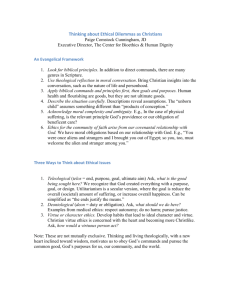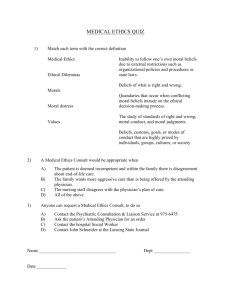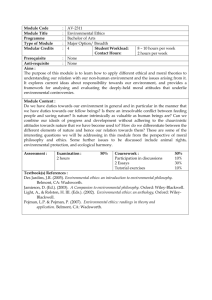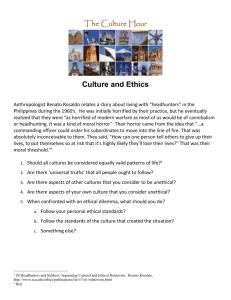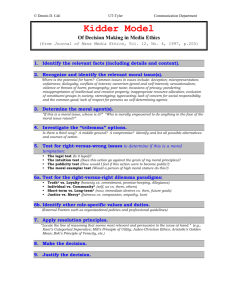The Seeing-Talking-Acting (STA - Society for Research into Higher
advertisement
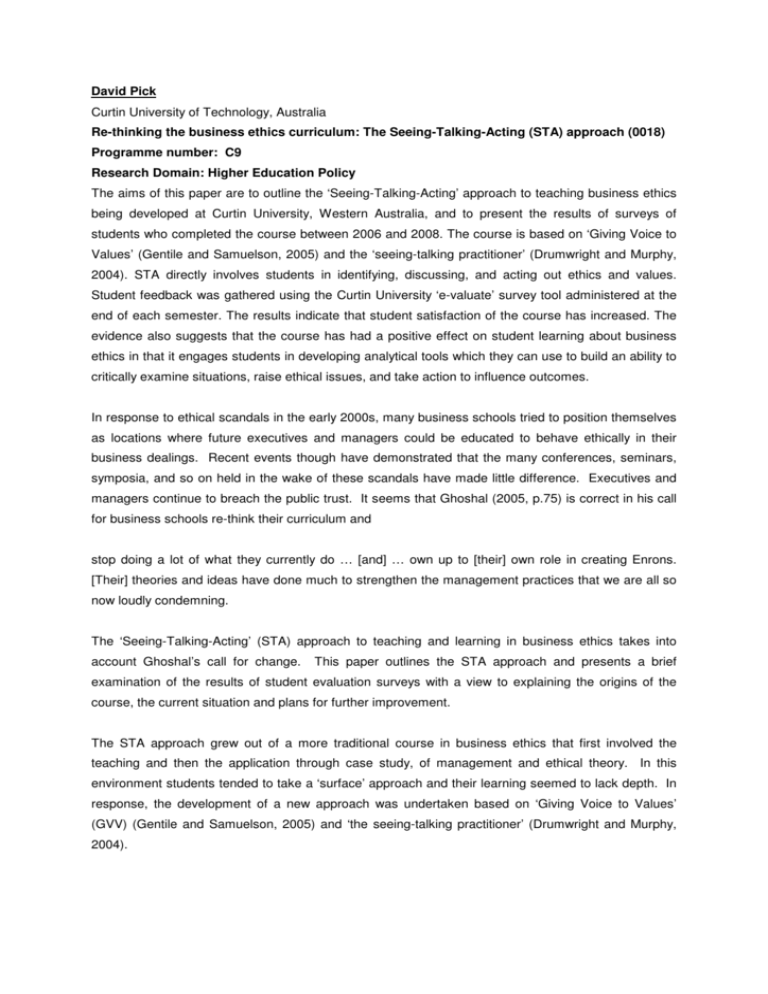
David Pick Curtin University of Technology, Australia Re-thinking the business ethics curriculum: The Seeing-Talking-Acting (STA) approach (0018) Programme number: C9 Research Domain: Higher Education Policy The aims of this paper are to outline the ‘Seeing-Talking-Acting’ approach to teaching business ethics being developed at Curtin University, Western Australia, and to present the results of surveys of students who completed the course between 2006 and 2008. The course is based on ‘Giving Voice to Values’ (Gentile and Samuelson, 2005) and the ‘seeing-talking practitioner’ (Drumwright and Murphy, 2004). STA directly involves students in identifying, discussing, and acting out ethics and values. Student feedback was gathered using the Curtin University ‘e-valuate’ survey tool administered at the end of each semester. The results indicate that student satisfaction of the course has increased. The evidence also suggests that the course has had a positive effect on student learning about business ethics in that it engages students in developing analytical tools which they can use to build an ability to critically examine situations, raise ethical issues, and take action to influence outcomes. In response to ethical scandals in the early 2000s, many business schools tried to position themselves as locations where future executives and managers could be educated to behave ethically in their business dealings. Recent events though have demonstrated that the many conferences, seminars, symposia, and so on held in the wake of these scandals have made little difference. Executives and managers continue to breach the public trust. It seems that Ghoshal (2005, p.75) is correct in his call for business schools re-think their curriculum and stop doing a lot of what they currently do … [and] … own up to [their] own role in creating Enrons. [Their] theories and ideas have done much to strengthen the management practices that we are all so now loudly condemning. The ‘Seeing-Talking-Acting’ (STA) approach to teaching and learning in business ethics takes into account Ghoshal’s call for change. This paper outlines the STA approach and presents a brief examination of the results of student evaluation surveys with a view to explaining the origins of the course, the current situation and plans for further improvement. The STA approach grew out of a more traditional course in business ethics that first involved the teaching and then the application through case study, of management and ethical theory. In this environment students tended to take a ‘surface’ approach and their learning seemed to lack depth. In response, the development of a new approach was undertaken based on ‘Giving Voice to Values’ (GVV) (Gentile and Samuelson, 2005) and ‘the seeing-talking practitioner’ (Drumwright and Murphy, 2004). Underpinning the design of learning and assessment outcomes and activities is the encouraging of critical thinking, creativity, and imagination. To some extent, this is apparent in the GVV initiative in that it makes wide use of case study material and discussion regarding how students can re-shape business decision-making. However GVV is focussed on post-graduate (MBA) education. The STA approach is aimed primarily at undergraduate students. The overall conceptualisation of the course content is based on the work of Drumwright and Murphy (2004) who advocate for the development of a ‘seeing-talking practitioner’. This means being able to recognise moral issues readily, discern and understand moral dimensions in a variety of situations, and profess a strong belief in the importance of having an overt, direct ethical dimension to communication. It also involves having moral courage (eg saying no to co-workers if one is asked to do something that is unfair and/or unethical). Being a seeing-talking practitioner enables people to be straightforward about their mistakes, freeing them from the need to lie about them or cover them up. All of this requires moral imagination and creativity characterised by Drumwright and Murphy (2004, p.17) as ‘being able to see and think outside the box, envisioning moral alternatives that others do not’. Learning outcomes for the course are designed around a set of key concepts and focus questions that connect to a set of learning experiences based on complex and unstructured practice situations for which there are no obvious solutions. Similarly, assessment is case study based in which the students are expected to develop and justify their own approach to the problems they are confronted with through reading, discussion, and experimentation. For example, one learning activity that forms part of an examination of stakeholder ethics is designed to examine child labour and raises awareness of the complexity of the issue. The students are divided into four groups adopting the roles of employers, employees, customers and ‘observers’. Each group is then asked to examine this issue from the perspective of their particular stakeholder role, decide what they would do and then engage in debate. It soon becomes clear to the students that simply condemning, or condoning by silence are inadequate responses. It also becomes clear that deciding what to do is a complex task. Reflective discussion provides students with opportunities to develop new possibilities, for example, sourcing and selling ‘no sweat’ products which would at least begin a process of change through stocking and marketing such goods. In doing this exercise students had practice seeing the moral dimensions, talking openly about them and developing alternative courses of action. Data about student perceptions of the course was conducted using the Curtin University ‘e-valuate’ student feedback system. The survey results show that overall student satisfaction of the course has increased (Table 1). Year/Semester 2006 - 1 2007 - 1 2007 - 2 2008 – 1 2008 – 2 % Satisfaction 78 84 86 95 93 Table 1. Student satisfaction 2006 to 2008. The survey also produced valuable qualitative data in the form of comments students added to the survey. Students have been able to develop analytical tools from which they can build an ability to critically examine situations, raise ethical issues, and take action to influence outcomes. The comments also showed evidence of engagement with the course content. A very challenging and eye-opening unit. Very relevant to everyday life and at times makes you a bit sad to see the reality of today’s business (Student Semester 1, 2007). It all makes me critically analyse my beliefs and that is extremely educational (Student Semester 1 2008). To date, this has been the most interesting unit I've done at Curtin in my … degree. This unit has helped open my eyes to a great deal of things, and has helped give me the tools I feel I will need to be ethical (Student Semester 2, 2008). The introduction of this course has had a positive effect on student learning about business ethics. However, it does require further improvement. Feedback from peers and students suggests that there needs to be more development of action. As a result, the unit is being re-organised for 2010. The course will have a greater focus on a smaller number of underpinning concepts, for example, moral muteness (Bird and Waters, 1989) and teleopathy (Goodpaster, 2004) and work needs to be done particularly with regard to the development of learning and assessment materials, and providing scaffolding and support for under-performing students. References Bird, F.B & Waters, J.A. (1989) The moral muteness of managers, California Manager Review, vol. 32, no. 1, pp.73-89. Drumwright, M.E. & Murphy, P.E. (2004) How advertising practitioners view ethics: Moral muteness, moral myopia, and moral imagination, Journal of Advertising, vol. 33, no. 2, pp.7-24. Gentile, M.C. & Samuelson, J.F. (2005) Keynote Address to the AACSB International Deans Conference, February 10, 2003: The State of Affairs for Management Education and Social Responsibility, Academy of Management Learning and Education, vol. 4, no. 4, pp.496-505. Ghoshal, S. (2005) Bad management theories are destroying good management practices, Academy of Management Learning and Education, vol. 4, no. 1, pp.75-91. Goodpaster, J.E. (2004, March/April) Ethics or excellence? Conscience as a check on the unbalanced pursuit of organizational goals, Ivey Business Journal, pp. 1-9.

